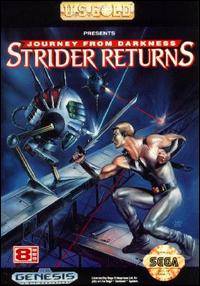Review | Screenshots | End Credits
Strider Returns: Journey From Darkness

Strider Returns: Journey From Darkness is not a true sequel to the coin-op. That "U.S. Gold" logo at the top of this game's cover means it was farmed out to a developer. Knowing that, the rest of us can breathe easier and sleep more soundly at night. Strider Returns deserves any and all flaming garbage tossed its way, because it is entirely unworthy to bear the name "Strider."
Yet it does. While this Strider game wasn't made by Capcom Japan, it is a Strider game, period. Many have wondered how U.S. Gold acquired the rights to make a Strider game in the first place, and thanks to Isuke, this has finally been answered. The Strider coin-op's success made Capcom salivate for a sequel. As Isuke developed the coin-op independently of Moto Kikaku and Masahiko "Patariro" Kurokawa, all of the coin-op's content that didn't overlap with the manga or the NES game was Capcom's intellectual property, to use as they wished. Capcom therefore owned all the elements that were recognizably "Strider" except for Hiryu himself. Realizing this, Capcom USA reached out to U.S. Gold (who, through Tiertex, had ported the coin-op to the Amiga, Amstrad CPC, C64, DOS, and ZX Spectrum) and tapped them for a sequel.
As it stood, Capcom USA could produce another Strider game but couldn't use Hiryu. Hiryu's ownership was hopelessly and gloriously complicated by Moto Kikaku's collaboration with Capcom, placing him beyond the reach of Capcom USA's licensing arm and U.S. Gold's grubby fingers. That didn't stop them from making the game, though. Capcom USA licensed out everything they could: Ton Pooh, the Amazons, Solo, and even Grandmaster Meio; but instead of Hiryu, you play as Hinjo, the candy-assed Strider who dresses in silver and green and talks like a surfer. Hinjo has to save his girlfriend Lexia ("Not the car, the babe!") from Grandmaster Meio, who's kidnapped her as part of a revenge conspiracy. Never mind that Hiryu defeated Meio, not Hinjo. The backstory in this game's manual is the stuff of legend, and should be read through at least once... for humor's sake. No lie. "Rumble on, Strider dude!" indeed.
 Hinjo's nowhere near as cool as Hiryu, but he does have some rather... unorthodox abilities. He can use shuriken or a sweep cypher instead of Falchion (which doesn't look nearly as cool). He's also equipped with a blaster rifle and the ability to transform into a kind of weird mecha... but it's difficult to control, and actually pulling off the transformation is iffy. The game sometimes triggers the transformation on its own.
Hinjo's nowhere near as cool as Hiryu, but he does have some rather... unorthodox abilities. He can use shuriken or a sweep cypher instead of Falchion (which doesn't look nearly as cool). He's also equipped with a blaster rifle and the ability to transform into a kind of weird mecha... but it's difficult to control, and actually pulling off the transformation is iffy. The game sometimes triggers the transformation on its own.
Strider Returns' level design is horrid. It uses a palette mostly consisting of brown and grey, and is far too linear, something that Strider was not. The levels in the Strider coin-op followed every path but a straight line. There are no robot helpers, either. Apparently Hinjo is too cool to have a terapodal robopanther. He should have a surfboard familiar, though, to make up for his lack of helpers. That would almost make this game better.
To their credit, the programmers at Tiertex have actually admitted that this game was one of their less-than-stellar efforts. Allan Findlay said it was the first thing he ever programmed, that the debugging "left a lot to be desired", and that "it could have been done better". Wayne Billington blamed "some huge fundamental problems all contributing to a big turd", among them the invention of "an alternative main character that turned an acrobatic character, into a slow dalek". And Anthony Ball gave a peculiar insight:
Strider II was originally designed by Andrew (Ingram) - he was a graphics artist at Tiertex. But it changed too much from Andrews original design, which would probably been a good game. Andrew went on to start Travellers Tales and designed Leander - a great platformer.
 Such frankness would almost make up for the fact that in some countries, this game was titled "Strider 2", which itself has caused no end of confusion. To those only casually interested in the series, this game IS "Strider 2", and among those are some who staunchly defend it. Some even believe that Capcom wanted to use this game as a template for a coin-op sequel. The poor unfortunate bastards. When Capcom Japan decided they wanted to make their own, official sequel, they pretended this one never existed, and one can hardly blame them.
Such frankness would almost make up for the fact that in some countries, this game was titled "Strider 2", which itself has caused no end of confusion. To those only casually interested in the series, this game IS "Strider 2", and among those are some who staunchly defend it. Some even believe that Capcom wanted to use this game as a template for a coin-op sequel. The poor unfortunate bastards. When Capcom Japan decided they wanted to make their own, official sequel, they pretended this one never existed, and one can hardly blame them.
Supposedly the Master System/Game Gear version of this game has vastly improved control and programming. If you absolutely must play this game, I recommend that that version. Avoid the Genesis version like the plague.
Further Reading
Review | Screenshots | End Credits